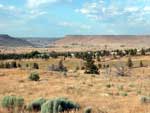 | | Landscape and Homes, north of Warm Springs. |
The Languages of the Warm Springs Indian Reservation have been handed down through countless generations and represent a living link to the past. If you ask any speaker of a heritage language how valuable their language is, you will likely be told that it is a priceless treasure. Languages are a gateway to memories and wisdom and the very life-blood of a cultural body.
|
|
Listen and read along with the spoken Kiksht (Wasco) language. Spoken by Valerie Switzler (Kiksht Language Specialist) and Deanie Johnson (Kiksht
Language Specialist). Recorded November 2002.
|
|
|
Suzie Slockish talks about the Ichishkiin (Warm Springs) and Sahaptin terms for the language, and the importance of retaining the language itself. (Interviewed by Brigette Whipple, August 2003 |
Language preservation was not an issue for any tribe until government policies were used to systematically eliminate them. This, combined with increased settlement by non-native persons, began putting substantial pressure on all heritage languages. Still, for the people of Warm Springs, English was either not spoken at all, or spoken strictly as a second-language, well into the 1950s, at which point younger generations came up as bi-lingual or English-only speakers. As the languages have declined, so have the practice of customs. Furthermore, the traditions, rituals, and languages that have served the people of the Warm Springs Reservation are surrounded by a world which does not value them. Their ability to practice these traditions is being slowly smudged away by the social and geographic transformations born of “progress.” And so, to combat this negative trend, language revitalization has become the core of an effort to resist loosing one’s identity, a fight for distinction. This is why people have poured their energy into saving their languages . . . this is mission of the Warm Springs Language Program.
|
|
Listen and read along to the spoken Ichishkiin (Warm Springs) language. Spoken by Arlita Rhoan (Ichishkiin Language Specialist and Elder). Recorded
November 2002.
|
|
|
Suzie Slockish talks about the time when only Indian languages were spoken. But after the reservations were established, only English was allowed to be be spoken. (Interviewed by Brigette Whipple, August 2003 |
Historical Vantage
The project of language revitalization, in the sense that we think of it today, started as a collaboration between speakers from the reservation and scholars from off-reservation. Certainly some of the oldest material documenting languages we have lies in a thesis written by Walter Dyk in 1933 on the grammar of Wishram and Wasq’u language. Work collected by Walter Dyk and Edward Sapir, trail-blazers in the field of linguistics, were collected as early as 1903. While the work of Walter Dyk has been influential in higher-education circles, it was not intended for, nor directly released to, the people of the Confederated Tribes of Warm Springs. It was not until the 1950s that interest in the notion of language revitalization and heritage continuation, not merely language documentation, would catch the attention of tribal members and scholars.
|
|
Rudy Clements, Wasco and Warm Sprigns elder, reflects on the stuggles and importance of retaining the Ichishkiin - Warm Springs, Kiksht - Wasco, and Numu - Paiute languages. (Interviewed by Rodney Frey, July 2003 |
During the 1950s and 1960s several concerned and visionary language speakers stepped forward to begin developing written alphabets and dictionaries, recording oral histories, and offering community classes. Some elders also regularly visited elementary school classrooms to offer language instruction there. During the 1970s and 1980s the Language Program brought aboard a Tribal Linguist, Henry Millstein, who helped further community classes and introduced simple language instruction tools on the computer. Although early emphasis was placed on the Sahaptin language (one of three belonging to this community), the Wasco language saw a revival of study during this period as well. Finally, in the 1990s and into the very beginning of the 21st century, this program emerged to where it is today, as tri-lingual education became a priority.
|
|
Listen and read along with the spoken Numu (Paiute) language. Patricia Miller (Numu Language Specialist). Recorded November 2002. |
|
|
Suzie Slockish talks the old days when the elders could not speak English, but were still able to communicate in the white man's world. (Interviewed by Brigette Whipple, August 2003 |
Contemporary Form
The Language Program has worked hard to develop lessons and coordinated curriculum sets for use in the public school system. By the end of 2002, all three languages were being introduced, at least two times a day and in 30-minute sessions, starting with the kindergarden grade and up through the 3rd grade. This school year carried another landmark as our teaching staff was able to follow the Warm Springs 5th grade class to middle school, which will be the first off-reservation educational experience for our children. Our curriculum covers introductory level language, such as greetings, common nouns, and words specific to cultural practices. During the 2002 - 2003 school year, over 400 students between Kindergarden and the fifth grade received language instruction.
In tandem with our public school outreach time, we also provide weekly classes open to all community members. These classes give the students longer exposure to language lessons and often draw a mixed crowd of youth and adults. As with all lessons, classtime lessons are frequently interwoven with traditional outings and chores, to re-enforce the symbiotic relationship between culture and language.
© Confederated Tribes of Warm Springs 2003
< previous | next >
|



